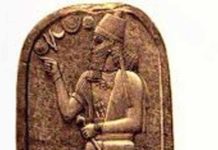
During the Neolithic period approximately 12,000 years ago, migrants began to establish permanent communities in the region of the Euphrates and Tigris rivers. This region, known as Mesopotamia, gave rise to several early civilizations that impacted western development. The geography of the region provided the greatest impact in the course of these developments.
The Land Known as Mesopotamia
The Euphrates and Tigris rivers flow into the Persian Gulf. The land is arid, forcing the inhabitants to develop intricate methods of irrigation. Cities like Babylon were connected to larger water sources through canals that flowed under the massive city walls.
Mesopotamia contained no natural barriers. There were no forests and there was no stone for building. Every structure was created from mud: bricks baked in kilns to ensure durability. The primary rivers were unpredictable, causing unforeseen flooding that often destroyed entire communities.
The Rise of City States Impacted by Geographic Limitations
City states like Ur, Erech, and Eridu flourished along the great rivers and their tributaries. Because of the openness of the land mass, these city-states built walls for protection. Nothing stood in the way of one city-state attacking another.
It can also be argued that this limitation was, in the long-term, highly beneficial in that civilizations rose and fell yet each one contributing toward the overall march of western civilization. Ancient Sumer contributed cuneiform writing while Nineveh is credited with establishing the first library.
From Babylon, the first recorded law code evolved while the Lydians provided the first consistent coin economy. Crude weapons ultimately gave way to more sophisticated metal weaponry even as the Assyrians perfected the art of siege warfare. Much of this was possible because geography forced civilizations to continually upgrade and develop new technologies.
Geography and the Evolution of Religious Beliefs
Gods and goddesses of Mesopotamia were uncaring and aloof. As seen in the Epic of Gilgamesh, deities were responsible for the destruction of the known world – the famous “flood story” found in several ancient Mesopotamian texts, and set themselves apart from humans. The Old Testament story of the “Tower of Babel” is an example of how the gods attempted to limit mankind’s reaching out to the heavens. The gods never stopped at reminding humans that a great gulf existed between the gods and their creation.
Every city-state was dominated by a ziggurat. These tiered temples stood in the middle of cities and every major road led to them. At the top, a temple allowed the high priest and the king to commune with the gods. It was believed that the gods lived in the heavens and thus the high place in ancient times figured prominently.
It was out of this polytheistic civilization that Abraham wandered east, communing personally with the one true god. This was the god who later recorded for Moses that he would have no other gods before him. The Hebrews perpetuated this monotheistic belief, setting them apart from surrounding civilizations.
The geography of Mesopotamia greatly contributed to the view of uncaring deities. The destructive river systems fed the idea that the gods really didn’t care. What kind of deity presides over scorpions and snakes? Daily life was harsh and tenuous. Why should the afterlife be any different?
The Land Between the Rivers
Mesopotamian geography demonstrates how topography impacts the rise and fall of civilizations. Geographic realities affected community limitations as well as providing an inevitable evolution among competing ancient powers.
Sources:
- Michael Grant, The Ancient Mediterranean (Penguin Putnam, 1965)
- Samuel Noah Kramer, Cradle of Civilization (Time Incorporated, 1967)






